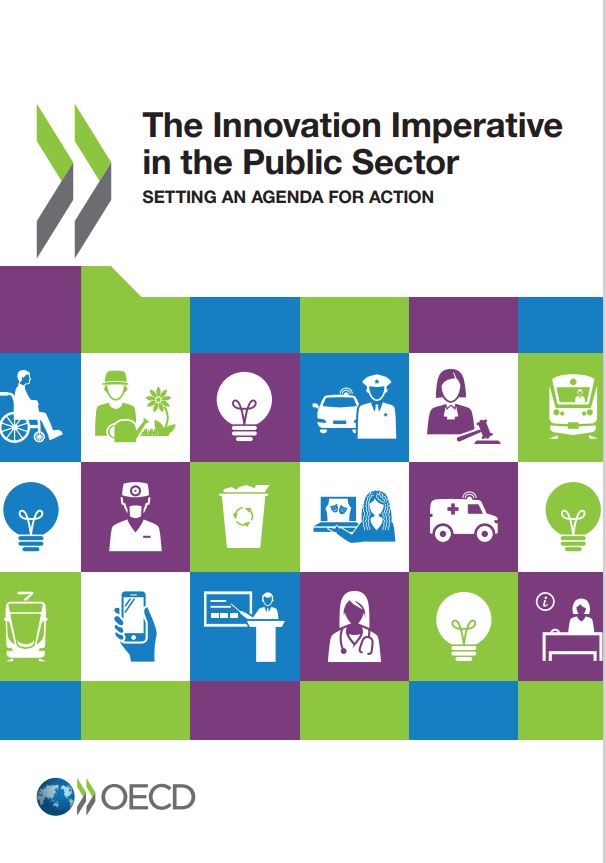The Innovation Imperative in the Public Sector: Setting an agenda for action

Executive summary
Governments are seeking to innovate: in how they work; in the services they provide and how they provide them; and in how they interact with citizens, businesses and civil society. These changes are being driven by different forces, including a more globalised and networked world, rising citizen expectations, new technologies, increasingly complex problems facing governments and – particularly since the 2008 economic crisis – tight budgets. Whatever the reason, the consensus seems clear: public sector organisations need new ways of working.
How does public sector innovation happen?
Drawing on recent experiences from national and sub-national governments available on the OECD’s Observatory of Public Sector Innovation, as well as lessons from the past, the OECD has developed an integrated framework for analysing public sector innovation. It identifies four levels where innovation takes place: 1) the individual innovator, 2) the organisation in which he or she operates, 3) the public sector as a whole and 4) society, and four organisational factors: people; knowledge; ways of
working; and rules and processes. Both the levels and factors are interlinked, and the borders between them are not always clear-cut. This framework can
guide future research, and forms the basis for the OECD “Innovation Imperative: A Call to Action” which identifies four areas that governments need to address to promote and enable public sector innovation (see Public Sector Innovation: An Agenda for Action).
The OECD has set out a call to action identifying four areas that governments need to address to promote and enable public sector innovation:
- Action 1: Focus on People
- Action 2: Put Knowledge to Use
- Action 3: Work Together
- Action 4: Rethink the Rules
Focus on people: Empowering the public sector workforce to achieve public sector innovation
Enabling innovation in public sector organisations means enabling the people who work in these institutions. People management helps to build innovative capacity in a great many ways, by ensuring that the right people with the right skills and talents are working in the right ways to maximise creative energy and see projects through to implementation. Motivating public servants to think and act in ways that lead to innovation requires a careful consideration of the reward structures in public sector organisations and the organisational climate and culture. How risk is handled and the way that experimentation and learning are encouraged can impact the willingness of employees to contribute their ideas and energy to innovation. Effective leadership that is able to inspire and ensure stable and effective working conditions can also contribute.
Put knowledge to use: Generating and sharing ideas in the public sector
Innovation does not just mean doing new things, but new things which are appropriate for the organisation in question and the community that it serves. To achieve this, organisations need access to accurate, good quality, usable information about their operations, their performance, their past experiences, their partners and the users that they serve. The availability and exploitation of such information and knowledge can support organisations to become “learning organisations” which grow, mature and
develop, by drawing on information and learning from their experiences and those of others. However, being able to tap into such knowledge poses challenges for public sector organisations. They need appropriate information systems in place to generate and manage data and information internally. Sharing and interoperability with other organisations across the public sector can support the exchange of appropriate information, while openness across society can facilitate the creation of public sector value and innovation across the economy.
Work together: Working in new ways to support public sector innovation
Few contemporary public sector organisations that are responsive and effective in targeting their citizens’ needs and desires can do so in isolation. Individual organisations hold different sets of information, have different resources and competencies to act in different areas. Developing a complete picture of the individual citizen, understanding what they need and the entry points where they can best access public services means that organisations need to work together. Country experiences demonstrate that collaboration and partnership are being supported by new ways of working – at team level with more flexible ways of organising teams and how their work is executed, to institutionalising co-design and user-centred services through innovation labs. Further work is required to understand when and where such approaches are appropriate, and in which circumstances they add value.
Rethinking the rules: Innovating within existing public sector rules, processes and procedures
Rules, processes and procedures enable large organisations to accomplish co-ordinated tasks in standardised ways, and therefore have a significant impact on the kind of work and innovation that an organisation can undertake. Clarifying and simplifying rules and regulations, and ensuring a minimum of red tape to ensure compliance with important protocol can open up space for innovation and ensure that employees share a collective understanding of where that space lies. The rules that control spending also have a strong impact on the ability for organisations to resource innovation, with more budget agility assumed to provide more opportunity to finance innovation projects. Additionally, the project management approaches themselves are processes that can either support or hinder effective innovation in public sector organisations. Various experimental approaches to project development that include piloting and prototyping may challenge traditional approaches to organisational transformation and require a different regulatory framework to reap potential innovation benefits.

The Innovation Imperative in the Public Sector: Setting an agenda for action
Published on 19 August 2015.
